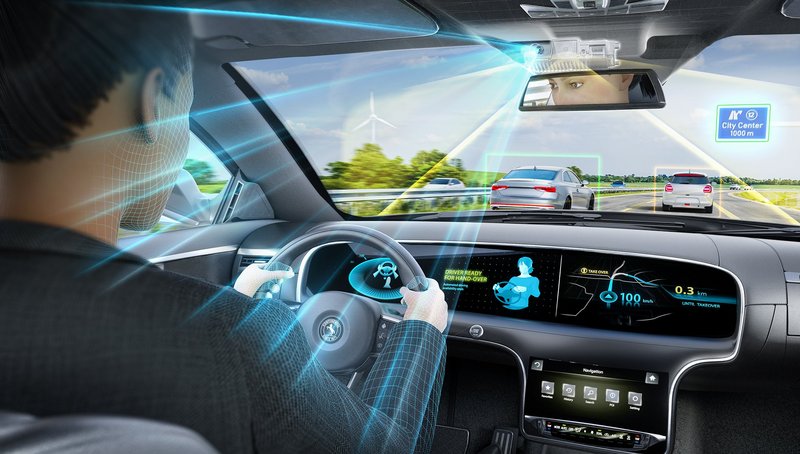Everything in View: Continental Combines the Front and Interior Camera for Automated Driving
- New system solution for safe transfer of driving responsibility in automated driving
- Infra-red interior camera provides important information on driver and passengers
- With the aid of artificial intelligence, special algorithms continuously adapt safety systems to vehicle occupants
Frankfurt am Main, Germany, August 13, 2019. One of the major challenges in automated driving is the safe transition from automated to manual driving. To achieve this, both a view out of and into the vehicle are required. The result is a holistic model of the environment comprising the traffic situation, the behavior of other road users, and the driver’s condition. Only when the information from the surroundings is in conformity with that from the interior, a safe transfer can take place. Technology company Continental has now developed an appropriate solution in the form of a combined camera system comprising an inward-looking infra-red camera and an outward-looking camera. This system monitors both the driver in the driver’s seat, continuously detecting whether he or she is able to take responsibility for driving, as well as the traffic situation in front of the vehicle.
The camera data, which is continuously evaluated by the relevant software, shows, for example, whether the driver is attentive or distracted, has turned to face the children on the rear seats, is looking at a smartphone or whether the driver’s hands are on the steering wheel or behind his or her head. “Thanks to the new camera system, vehicle and driver are constantly aware of one another. Ultimately, this comes down to trust. The human can rest assured that the technology will not abruptly hand back responsibility without warning, but that this will take place according to clear and comprehensible criteria,” says Georg Binder, Head of Strategy & Planning, Advanced Driver Assistance System business unit at Continental.
Holistic camera system as a prerequisite for automated driving
With a broad portfolio of camera systems, Continental offers various options for implementing such a function in accordance with customer requirements. In addition to modular solutions, it is also possible to use existing installation spaces. The so-called “Road AND Driver” camera is located behind the windshield of the vehicle, above the rear-view mirror. It is installed at the same location as the existing camera, the lens of which is aimed at the road ahead and provides the data for advanced driver assistance systems. Cameras play a key role in the implementation of modern driver assistance systems and are an integral part of the sensors for automated driving. Features of the new camera generation are excellent night vision characteristics and high image resolution, which now ranges from one to eight megapixels, as well as an aperture of up to 125 degrees, enabling cross-traffic objects to be detected even earlier. In addition to conventional computer vision processes, neural networks are used that can be scaled to match the available hardware.
In combination with an interior camera that detects the position of the driver, the direction of his or her gaze, and the location of his or her hands with certainty – such a system is considered a prerequisite for bring cars featuring automated driving functions onto the road. This is because automated driving will be possible only when the transition between “automated” and “manual” driving modes is safe and reliable. Drivers must be able to trust that the vehicle will hand over responsibility only when they are ready to accept it.
Interior monitoring optimizes restraint systems
However, the data from the interior camera is not only evaluated for the safe transfer of driving functions. With the aid of the Occupant Safety Monitor software function, it can also be used to adapt passive safety systems such as seatbelts and airbags to the prevailing situation. The deployment of airbags, for example, can be tailored to the situation detected in the interior in order to optimize its protective effect.
An important aspect of the “Road AND Driver” camera’s interior monitoring system is that the camera data is evaluated – but not recorded. “The focus is solely on interpreting the prevailing situation in the vehicle in order to increase the safety of the occupants and other road users,” says Andreas Forster, Next Generation Technology manager in Continental’s Passive Safety & Sensorics business unit.
Driver Monitoring – part of Euro NCAP’s future roadmap
The consumer protection organization Euro NCAP has included the topics of driver monitoring and so-called baby or child monitoring in closed vehicles in the agenda in order to enhance road safety and contribute to vision Zero, a future without fatalities or injuries and without accidents on the roads. Distraction, fatigue, or forgetting about small children or sleeping babies in the vehicle are risks that can be minimized by Continental's new camera system. It provides valuable data on the basis of which appropriate countermeasures can be initiated.
The exact scenarios that will be relevant in the upcoming Euro NCAP regulations have not yet been finalized. However, it is already clear that such new requirements will have to be met from 2020 or 2022. At the later point, the “Road AND Driver” camera from Continental will already be on the market, with the start of series production planned for 2021. The first automated vehicles are then also likely to be on the roads, equipped with camera systems to monitor the road and the interior. Continental is already able to demonstrate the functions of this technology and use it for new safety systems – perfectly in keeping with the spirit of Vision Zero, a future without road accidents.

Sören Pinkow
Media Spokesperson Autonomous Mobility and Commercial Vehicles
Continental Automotive

